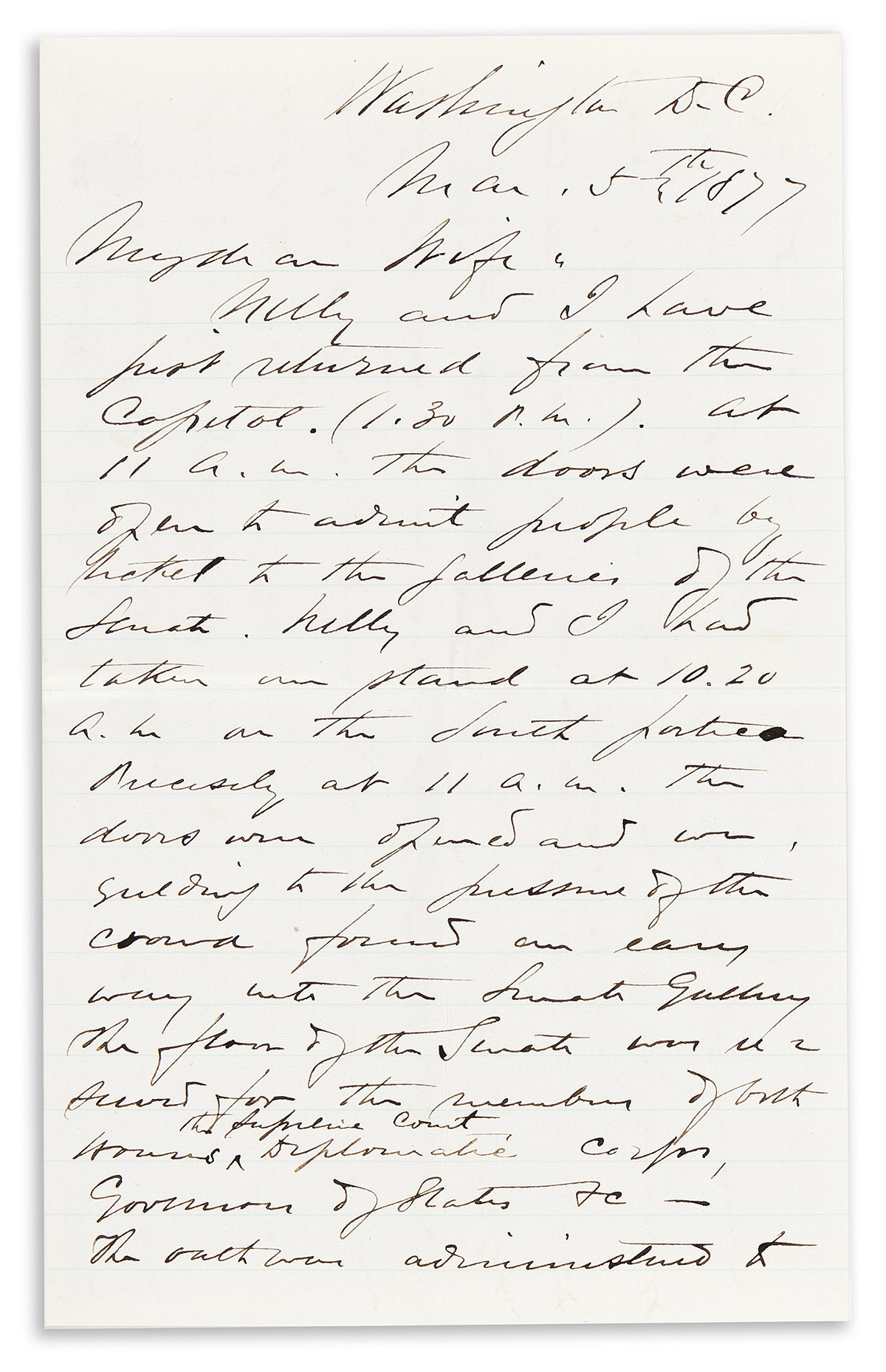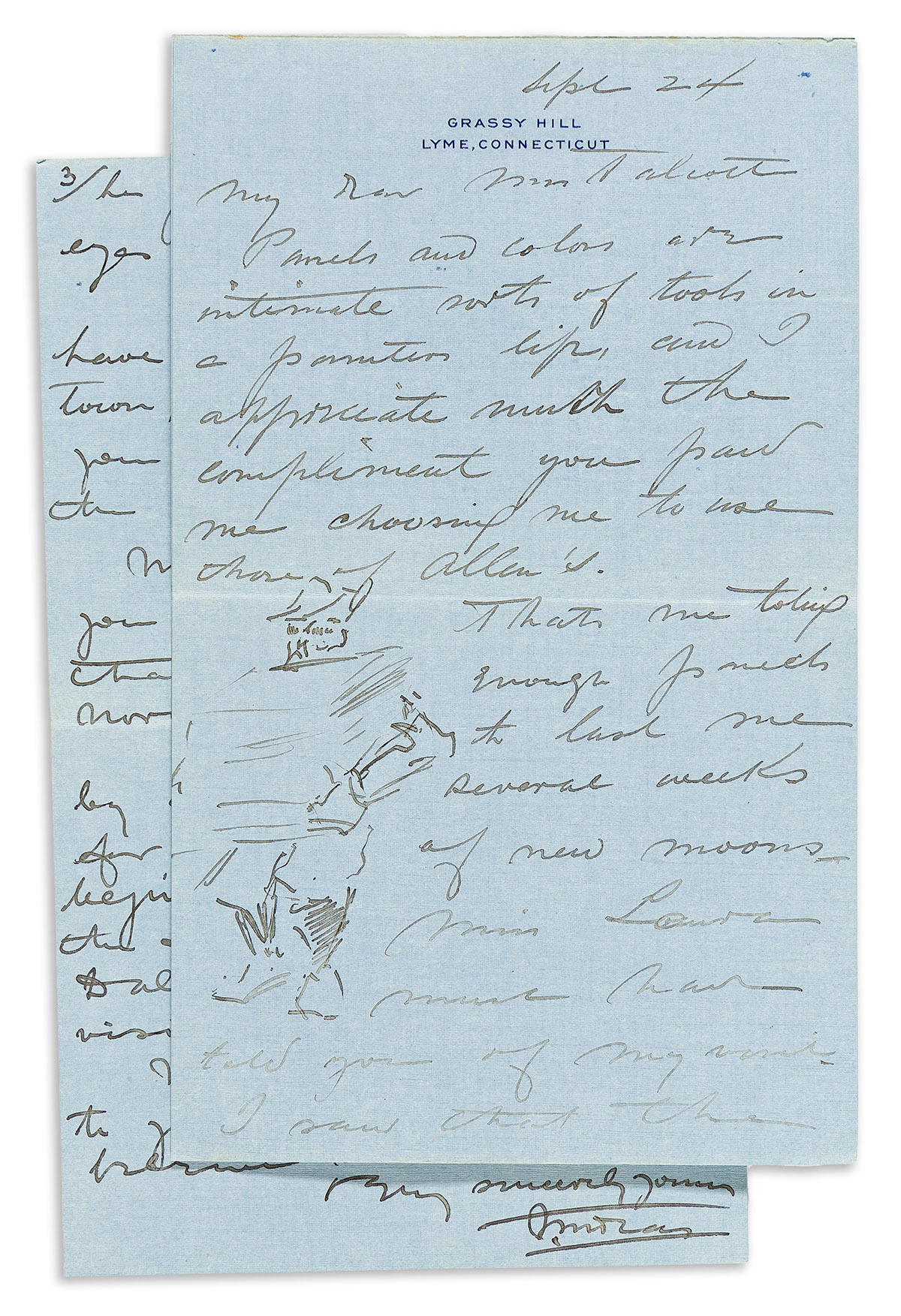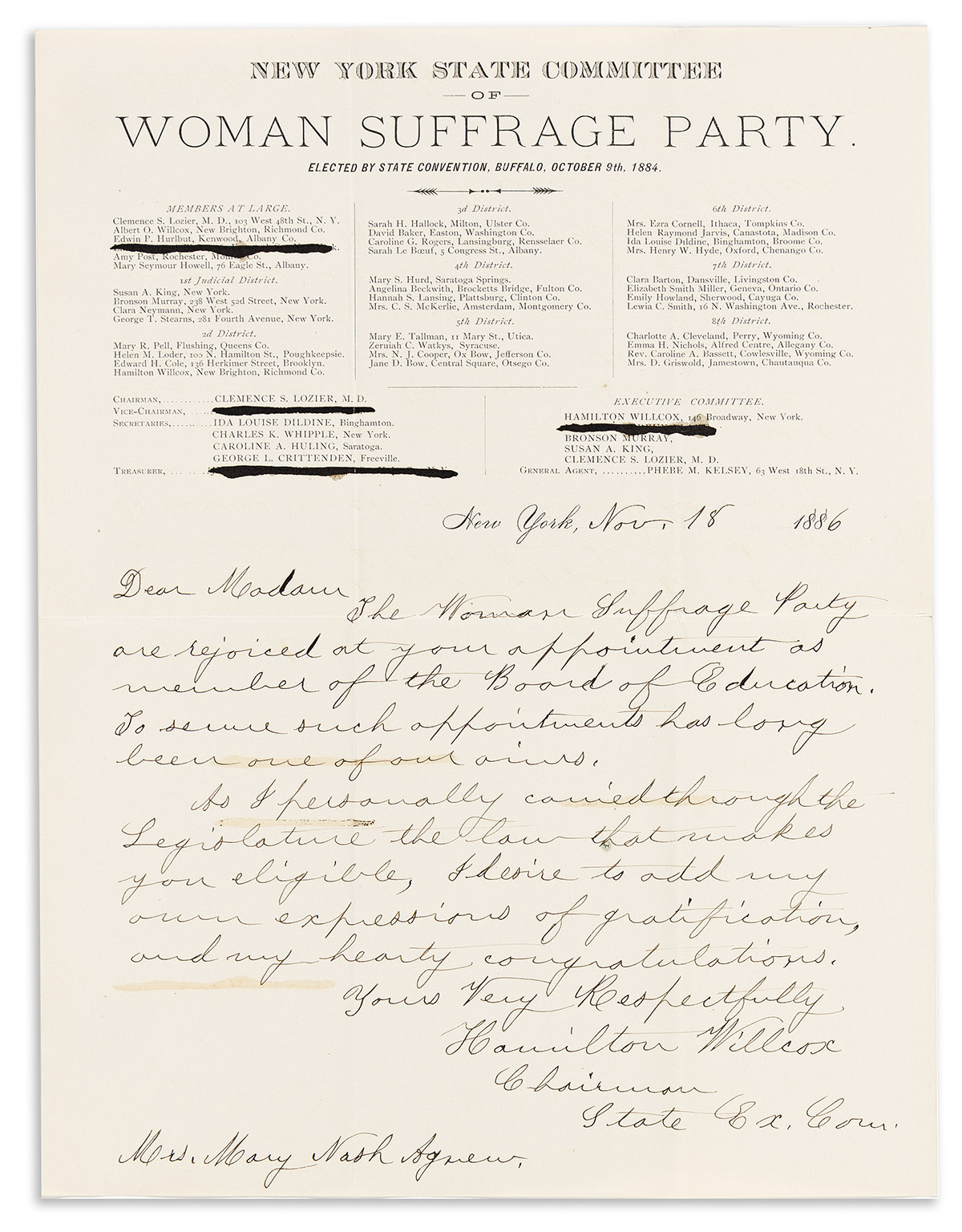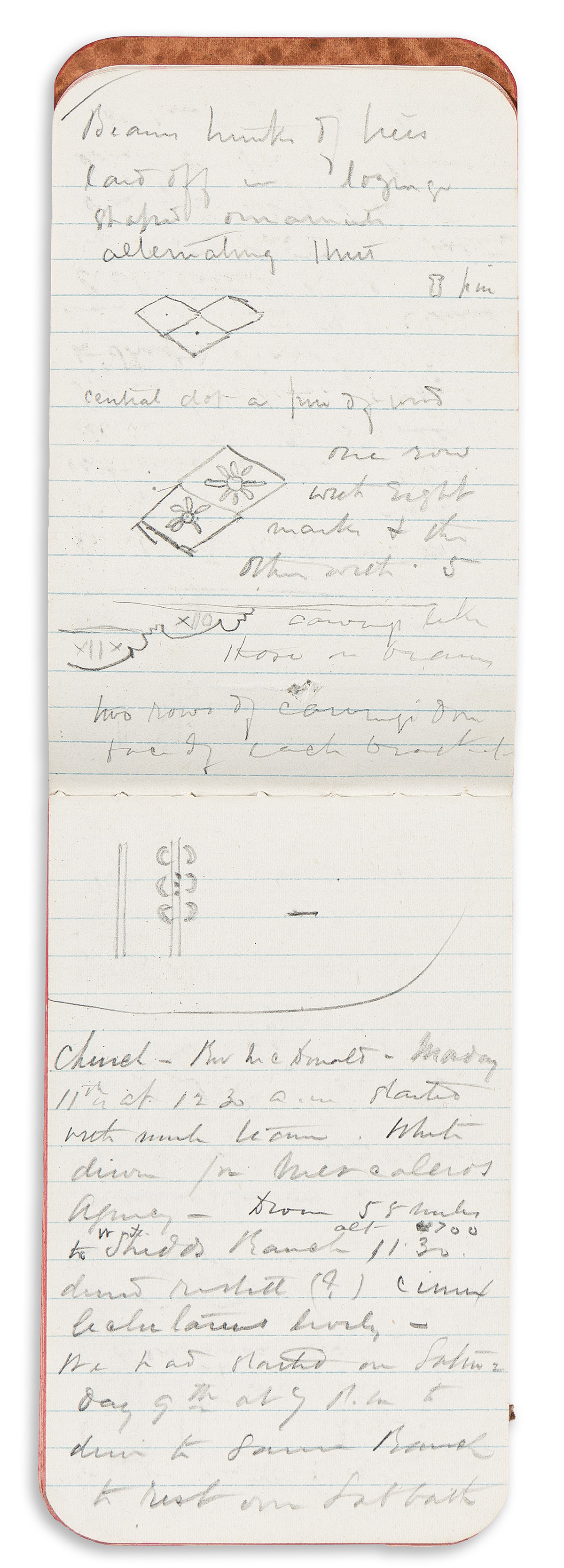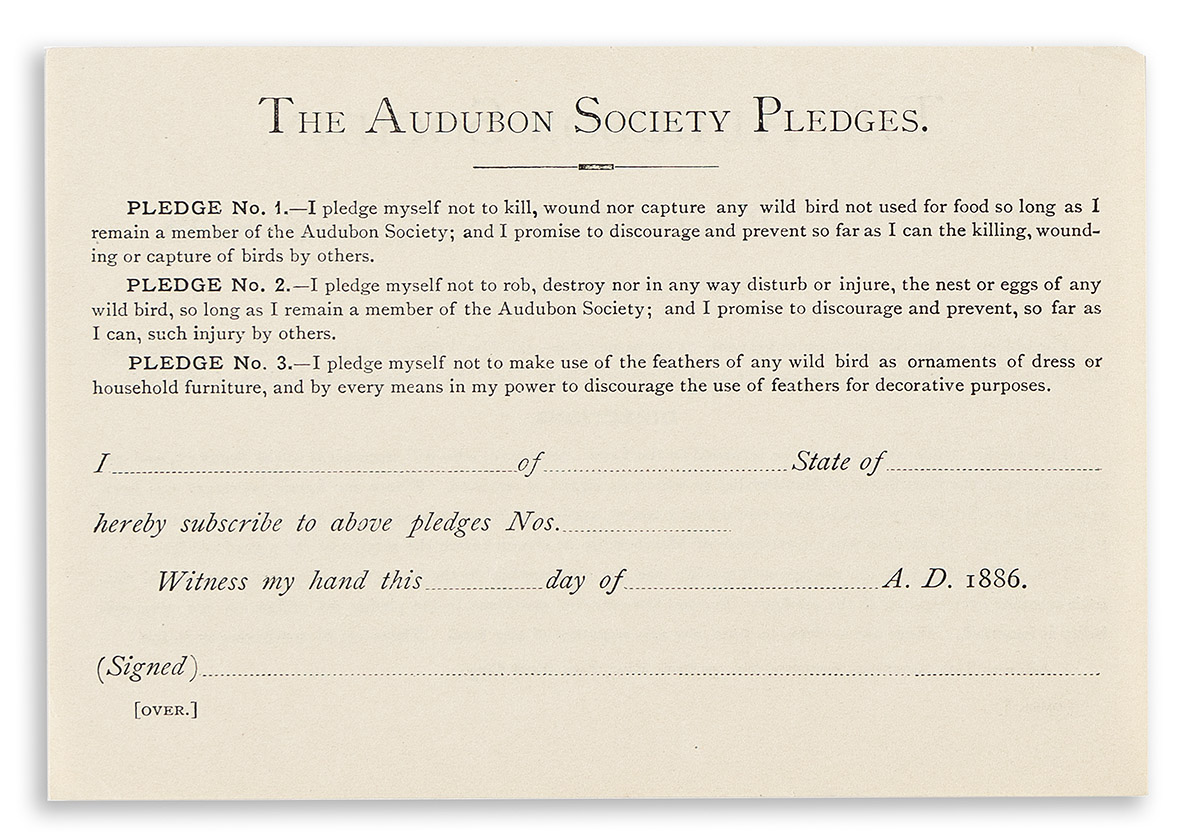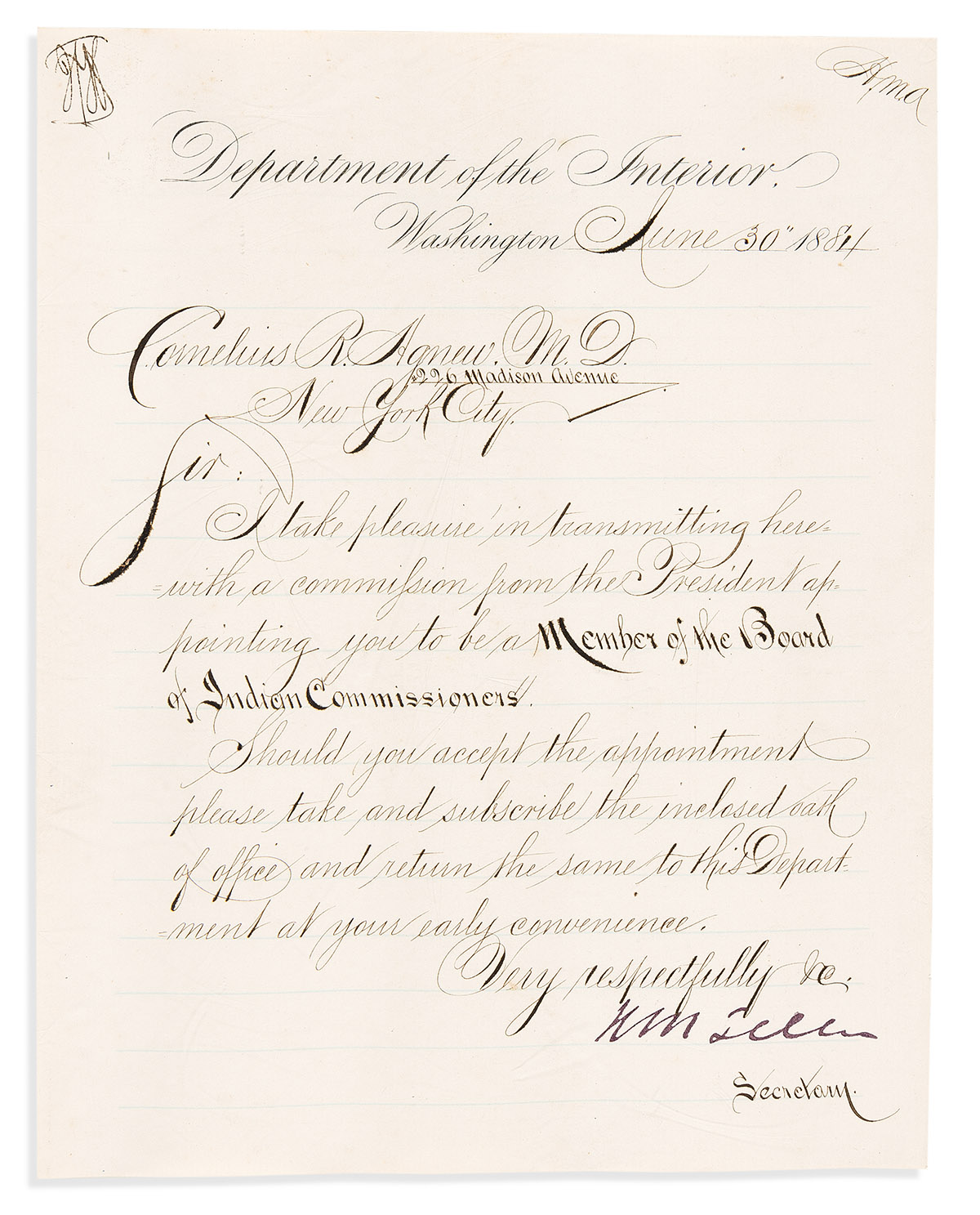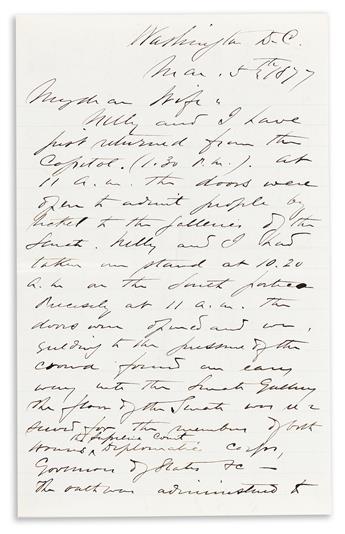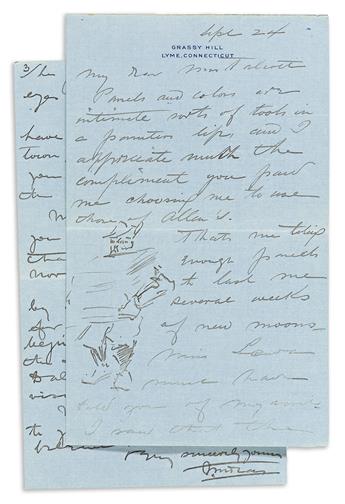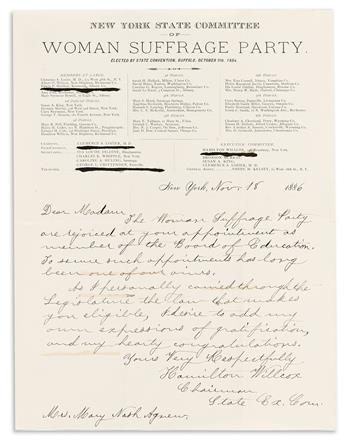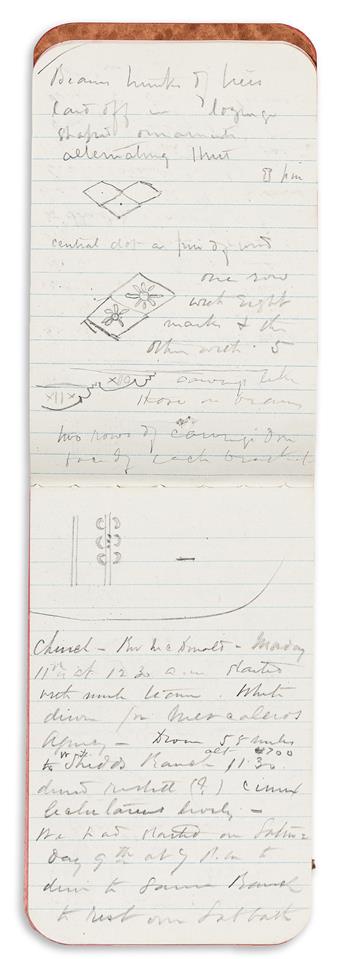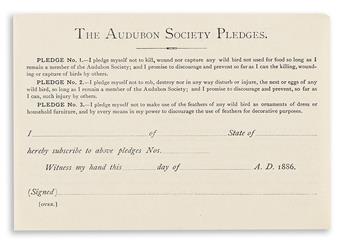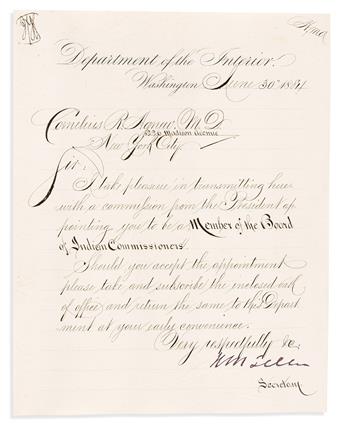Sale 2687 - Lot 130
Price Realized: $ 11,000
Price Realized: $ 13,750
?Final Price Realized includes Buyer’s Premium added to Hammer Price
Estimate: $ 3,000 - $ 4,000
(FAMILY PAPERS.) Extensive family papers of noted physician Cornelius R. Agnew. Thousands of items (2 linear feet), consisting largely of family and personal correspondence, largely unsorted, condition generally strong. Various places, bulk 1859-1920
Additional Details
Cornelius Rea Agnew (1830-1888) of New York had a varied and influential career in medicine. Graduating from Columbia College and the New York College of Physicians and Surgeons, he was a surgeon at New York Hospital and the New York Eye and Ear Infirmary, Surgeon-General of the State of New York and the state militia, and ran the New York Volunteer Hospital during the Civil War. He was also a leading figure in the creation of the United States Sanitary Commission during the war. For the last 19 years of his life was a professor of eye and ear diseases at the College of Physicians and Surgeons.
Dr. Agnew married Mary Nash Agnew (1830-1918) in 1856. They had one son, William; and seven daughters, Eleanor, Laura, Elizabeth, Sarah, Edith, Katherine and Anne. Of these, Katharine Nash Agnew Talcott (1870-1956) is most heavily represented here; in 1905 she married artist Allen Butler Talcott (1867-1908) of the famous Old Lyme artist colony in Connecticut.
The collection includes 15 letters Agnew wrote to his wife during the Civil War, while he was involved in the Sanitary Commission and running a military hospital. His 10 July 1861 letter describes his arrival in Washington to help with the Sanitary Commission. On 4 May 1864, the eve of the Battle of the Wilderness, he wrote "I expect to go to the Army tomorrow. . . . Government keeps everything so well concealed that no one here knows where Grant is or what he means to do. For the first time in the history of the war, science of silence & concealment is well practiced. . . . I doubt if the President knows what is going on." As the war drew to a close, on 20 March 1865 he wrote "Such scenes of suffering as I have encountered[?] among the returned prisoners would convulse you with grief. . . . 3,000 returned prisoners are still here, lying or hobbling in every form of starvation. Nearly one hundred have lost one or both feet or parts of feet from frost & hunger & the others lie like dried sticks in the hospital wards or stalk about like moving skeletons. . . . Many of them are in a mental condition resembling idiocy. Some of them crawl around on hands & knees like mangy dogs & whine for food. Others have lost their memory & cannot tell their names."
Other Civil War correspondence includes a letter from brother Alexander Agnew in New York on 12 May 1864, who attended the funeral of General John Sedgwick: "I today stood by the lifeless form of brave Gen'l Sedgwick & bowed my head out of respect for that noble man who had done so much for his country." On 21 August 1864, a disabled former patient named John W. Perkins writes to Agnew from Kennebunk, ME to thank him for "the real kindness and attention I received from you" while in a military hospital": "My leg . . . has improved very much since I last saw you. The sores are nearly healed. . . . There have no more pieces of bone made their appearance since I saw you."
Among his many other letters to his wife, Agnew wrote a 11 July letter (no year) describes a camping trip to Raquette Lake in the Adirondacks. His long 24 January 1887 letter describes a visit to Mexico City. He wrote three letters from Washington in early March 1877 just as the Hayes-Tilden election was being resolved in Congress. On 1 March, he wrote "the end is now very near and the result will be for Hayes beyond a doubt"; that result was announced the next day. On 5 March he describes the Hayes inauguration at length. On 8 March he describes a meeting with ex-Confederate general Dick Taylor, "an unreconstructed rebel, a pessimist of the worst type."
Agnew was appointed to the board of the New York State Hospital for the Insane at Poughkeepsie in 1867; a 19 March letter from a Dr. Cleaveland informs that the other board members are solid except for a homeopathic doctor friend of the governor, but "we are sufficiently strong to manage this little pill doctor."
He was also appointed to the federal Board of Indian Commissioners in 1884. Included is his commission for this post, as well as a 38-page diary of a trip he took with the commissioners, 28 July to 22 August 1884. They visited the Kaw and Osage Agencies in Oklahoma Territory on 2 August, then on to Colorado City and El Paso, TX, and the Mescalero Apache Agency and Laguna in New Mexico before returning eastward. He concludes the diary with several pages of "Points for met'g of Bd of Indian Commissioners." He saw potential in compulsory schooling, and in the recruitment of Indians into segregated Army regiments. Interestingly, he thought both white and black soldiers would be bad influences, "as it is well known many of our recruits in the Army are persons unfit to aid in the elevation of those with whom they are associated." He supported Indian suffrage: "There are men in every tribe well fitted to be in Congress and to fill every office."
Dr. Agnew's other personal papers include his 1858 European passport and 1859 commission as surgeon-general of the New York State Militia; and papers regarding his service in the 1880 Electoral College.
Mary Nash Agnew's work as a Commissioner of Common Schools in New York is documented by numerous letters and documents from 1886 onward, including correspondence with Mayor Abram Hewitt. A congratulatory letter from the state's Women Suffrage Party on 18 November 1886 notes: "To secure such appointments has long been one of our aims."
The family had varied real estate investments. A folder relates to their investment in the Rugby Tennessee Company, including a large printed map. They also owned a cottage in remote Montauk, NY at the far eastern tip of Long Island (now a bustling resort area). Some of the daughters' letters are dated from Montauk, and a pair of 1905 letters from a neighbor discuss the complexity of running a phone line there.
The Agnews' noted artist son-in-law Allen Butler Talcott (1867-1908) is represented here by a long 1 May 1897 letter he wrote from Cordoba, Spain; an illustrated letter to his mother-in-law from a Lyme artist who had been bequeathed his art supplies; and a resolution upon his death by the Connecticut League of Art Students. We suspect additional mentions of him will be found in the unsorted family correspondence.
Among the printed ephemera are 4 copies of a printed slip for the "Audubon Society for the Protection of Birds," printed in its founding year in 1886, for members pledging not to kill or molest birds; along with a 4-page membership circular. This was the precursor of the modern Audubon Society founded in 1895.
We have examined only a tiny portion of the thousands of family letters offered in this archive, many of which remain still folded.
Dr. Agnew married Mary Nash Agnew (1830-1918) in 1856. They had one son, William; and seven daughters, Eleanor, Laura, Elizabeth, Sarah, Edith, Katherine and Anne. Of these, Katharine Nash Agnew Talcott (1870-1956) is most heavily represented here; in 1905 she married artist Allen Butler Talcott (1867-1908) of the famous Old Lyme artist colony in Connecticut.
The collection includes 15 letters Agnew wrote to his wife during the Civil War, while he was involved in the Sanitary Commission and running a military hospital. His 10 July 1861 letter describes his arrival in Washington to help with the Sanitary Commission. On 4 May 1864, the eve of the Battle of the Wilderness, he wrote "I expect to go to the Army tomorrow. . . . Government keeps everything so well concealed that no one here knows where Grant is or what he means to do. For the first time in the history of the war, science of silence & concealment is well practiced. . . . I doubt if the President knows what is going on." As the war drew to a close, on 20 March 1865 he wrote "Such scenes of suffering as I have encountered[?] among the returned prisoners would convulse you with grief. . . . 3,000 returned prisoners are still here, lying or hobbling in every form of starvation. Nearly one hundred have lost one or both feet or parts of feet from frost & hunger & the others lie like dried sticks in the hospital wards or stalk about like moving skeletons. . . . Many of them are in a mental condition resembling idiocy. Some of them crawl around on hands & knees like mangy dogs & whine for food. Others have lost their memory & cannot tell their names."
Other Civil War correspondence includes a letter from brother Alexander Agnew in New York on 12 May 1864, who attended the funeral of General John Sedgwick: "I today stood by the lifeless form of brave Gen'l Sedgwick & bowed my head out of respect for that noble man who had done so much for his country." On 21 August 1864, a disabled former patient named John W. Perkins writes to Agnew from Kennebunk, ME to thank him for "the real kindness and attention I received from you" while in a military hospital": "My leg . . . has improved very much since I last saw you. The sores are nearly healed. . . . There have no more pieces of bone made their appearance since I saw you."
Among his many other letters to his wife, Agnew wrote a 11 July letter (no year) describes a camping trip to Raquette Lake in the Adirondacks. His long 24 January 1887 letter describes a visit to Mexico City. He wrote three letters from Washington in early March 1877 just as the Hayes-Tilden election was being resolved in Congress. On 1 March, he wrote "the end is now very near and the result will be for Hayes beyond a doubt"; that result was announced the next day. On 5 March he describes the Hayes inauguration at length. On 8 March he describes a meeting with ex-Confederate general Dick Taylor, "an unreconstructed rebel, a pessimist of the worst type."
Agnew was appointed to the board of the New York State Hospital for the Insane at Poughkeepsie in 1867; a 19 March letter from a Dr. Cleaveland informs that the other board members are solid except for a homeopathic doctor friend of the governor, but "we are sufficiently strong to manage this little pill doctor."
He was also appointed to the federal Board of Indian Commissioners in 1884. Included is his commission for this post, as well as a 38-page diary of a trip he took with the commissioners, 28 July to 22 August 1884. They visited the Kaw and Osage Agencies in Oklahoma Territory on 2 August, then on to Colorado City and El Paso, TX, and the Mescalero Apache Agency and Laguna in New Mexico before returning eastward. He concludes the diary with several pages of "Points for met'g of Bd of Indian Commissioners." He saw potential in compulsory schooling, and in the recruitment of Indians into segregated Army regiments. Interestingly, he thought both white and black soldiers would be bad influences, "as it is well known many of our recruits in the Army are persons unfit to aid in the elevation of those with whom they are associated." He supported Indian suffrage: "There are men in every tribe well fitted to be in Congress and to fill every office."
Dr. Agnew's other personal papers include his 1858 European passport and 1859 commission as surgeon-general of the New York State Militia; and papers regarding his service in the 1880 Electoral College.
Mary Nash Agnew's work as a Commissioner of Common Schools in New York is documented by numerous letters and documents from 1886 onward, including correspondence with Mayor Abram Hewitt. A congratulatory letter from the state's Women Suffrage Party on 18 November 1886 notes: "To secure such appointments has long been one of our aims."
The family had varied real estate investments. A folder relates to their investment in the Rugby Tennessee Company, including a large printed map. They also owned a cottage in remote Montauk, NY at the far eastern tip of Long Island (now a bustling resort area). Some of the daughters' letters are dated from Montauk, and a pair of 1905 letters from a neighbor discuss the complexity of running a phone line there.
The Agnews' noted artist son-in-law Allen Butler Talcott (1867-1908) is represented here by a long 1 May 1897 letter he wrote from Cordoba, Spain; an illustrated letter to his mother-in-law from a Lyme artist who had been bequeathed his art supplies; and a resolution upon his death by the Connecticut League of Art Students. We suspect additional mentions of him will be found in the unsorted family correspondence.
Among the printed ephemera are 4 copies of a printed slip for the "Audubon Society for the Protection of Birds," printed in its founding year in 1886, for members pledging not to kill or molest birds; along with a 4-page membership circular. This was the precursor of the modern Audubon Society founded in 1895.
We have examined only a tiny portion of the thousands of family letters offered in this archive, many of which remain still folded.
Exhibition Hours
Exhibition Hours
Aliquam vulputate ornare congue. Vestibulum maximus, libero in placerat faucibus, risus nisl molestie massa, ut maximus metus lectus vel lorem.



